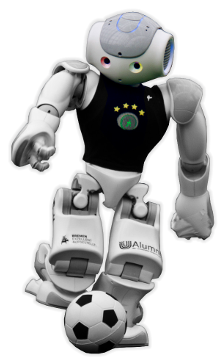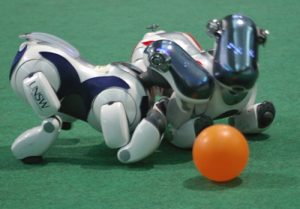
From 1992, researchers in the fields of robotics, artificial intelligence, and multi-robot systems began coalescing around the idea of using the soccer domain to promote scientific and technological advancements. Whilst the game of soccer was obviously socially appealing, it was seen within the research community as a feasible but formidable long term challenge to pursue. The international RoboCup event was conceived as part of a landmark project whose stated aim was to, by the middle of the 21st century, field a team of fully autonomous humanoid robot soccer players that were capable of winning a soccer game, complying with the official rules of FIFA, against the winner of the most recent World Cup.
The inaugural RoboCup was held during the IJCAI-97 conference in Nagoya, and attracted 42 teams from around the world who participated in three competitions; Simulation, Small Sized, and Medium Sized leagues. An important component of RoboCup events has been the associated symposiums where key note speakers have presented on seminal topics and presentations are given by members of competing teams on their research achievements.
The RoboCup Federation has since added regional events to the program to give teams more opportunities to test their research outcomes in uncontrolled environments against real opponents. And, as new social challenges have emerged, other competition formats, including RoboCup Rescue, RoboCup@Home, RoboCup Industrial, and RoboCupJunior, have been introduced at RoboCup events.
Standard Platform League
A new league, the Standard Platform (SPL) kicked off in Paris, France at RoboCup 98, the same year that France hosted the FIFA World Cup, and drew large interest from both the public and media. The intent of the SPL was to utilise a commercially viable robot system, whereby teams would focus specifically on the software engineering problems associated with robotic soccer players. At its inception, the Sony AIBO, a four legged dog-like autonomous robot, was used as the standard platform and the league was commonly referred to as the ‘Legged League’. In 2008, the NAO robot, a humanoid biped, was introduced to the league, and that year saw two standard platforms in use. With the unfortunate withdrawal of the AIBO from the market, the NAO robot became the sole standard platform for the league from 2009 onwards.
In addition to the SPL, other biped soccer leagues, under the humanoid league banner (that include kid sized, teen sized, and adult sized robots) participate in RoboCup events.
Research and Development
Research is an important aspect of RoboCup events and is fully embraced within the SPL. Participation in the league requires teams to conduct research and publish papers about its outcomes. At each RoboCup event, teams prepare posters about their research goals and objectives and give small presentations to their cohort, and team members are also encouraged to present their work at the RoboCup symposiums.
Research challenges and problems within the SPL are based on, but not limited to, autonomous but cooperative behaviours between player robots, and include subject areas such as:
- Biped motions for walking, kicking, getting up after falls, picking up the ball,
- Vision processing and detection of balls, goals, lines, and other robots (which wear team jerseys),
- Localisation must be performed in a playing environment that contains no robot specific aids where the playing field is symmetrical,
- Individual and team based behaviours for players and goalie, and
- Inter-robot communication, including responding to sound cues.
These research challenges are compounded by the limited processing capacity available on the robot’s platform as no off-line processing is permitted.
Competition History
The league has a rich history of participating teams, with universities such as CMU, University of NSW, amongst others competing in the league from its early days and who continue to participate to this day. The league has also had a number of very successful teams over the years, including B-Human and rUNSWift. The SPL website catalogues each year’s results and records impressive achievements on the SPL Hall of Fame page.

